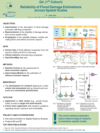PhD-Project Q4 by Tobias Sieg (UP):
Analysing changes in micro-scale flood related vulnerability of companies
Timescale: Oct. 2015 – Sept. 2018
Supervisors:
Dr. Heidi Kreibich, Helmholtz Centre Potsdam GFZ German Research Centre For Geosciences
Prof. Dr. Frank Scherbaum, University of Potsdam
Background
Hydro-meteorological hazards have a high damage potential in form of e.g. riverine and pluvial floods, winter storms, hurricanes and tornadoes, which can occur all over the globe. Along with an increasingly warm climate also an increase in extreme weather which potentially triggers natural hazards can be expected. Yet, not only changing natural systems, but also changing societal systems contribute to an increasing risk associated with these hazards. These can comprise increasing exposure and possibly also increasing vulnerability to the impacts of natural events. Thus, appropriate risk management is required to adapt all parts of society to existing and upcoming risks at various spatial scales. One essential part of risk management is the risk assessment that include the estimation of the economic impacts. However, reliable methods for the estimation of economic flood impacts due to hydro-meteorological hazards are still missing.
Objectives and Methods
This project dealt with the question of how the reliability of hazard damage estimates can be improved, represented and propagated across all spatial scales. This question was investigated using the specific example of economic impacts to companies as a result of riverine floods in Germany.
In this project tree-based models trained with survey data are used for the estimation of direct economic flood impacts on companies. However, despite the performance improvements induced by using multiple variables and more data points for the derivation of the models, large prediction errors remain at the object level. In addition to the missing representation of the uncertainty associated with the description of the damage process, current approaches also mostly ignore the uncertainty associated with the exposed objects and the characteristics of the hazard. Furthermore, state-of-the-art approaches also imply problems of missing consistency when predicting the damage at different spatial scales due to the use of different types of exposure data sets for model derivation and application. Inconsistencies within the exposure data sets themselves, as e.g. land use data sets, introduce additional uncertainties. In order to face these issues a novel object-based method was developed in this thesis.
Main results
- Comprehensive analyses of damage processes affecting companies during fluvial floods with Random Forests. The improvement of the model performance by the means of multi-variable models and additional data points is possible, but small.
- Novel method for the estimation of hydro-meteorological risk was developed. The method resolves differences between risk assessments at different spatial scales, quantifies uncertainties associated to hydrological risk and damage assessments and enables the use of newly available exposure data such as openstreetmap data sets.
- The application and validation of the method resulted in plausible estimations without overestimating the uncertainty at all spatial scales.
- Linked estimation of direct and indirect economic flood impacts in Germany under consideration of uncertainties.
Publications within NatRiskChange:
AGARWAL, A., BOESSENKOOL, B., FISCHER, M., Hahn, I., Köhn, L., LAUDAN, L., MORAN, T., OZTURK, U., Riemer, A., Rözer, V., SIEG, T., VOGEL, K., WENDI, D., Bronstert, A., Thieken, A.H. (2016): Die Sturzflut in Braunsbach, Mai 2016 - Eine Bestandsaufnahme und Ereignisbeschreibung. Taskforce im Rahmen des DFG-Graduiertenkollegs Natural Hazards and Risks in a Changing World, Universität Potsdam (Publisher), 20 pages, urn:nbn:de:kobv:517-opus4-394881.
Kuhlicke, Ch., Masson, T., Kienzler, S., SIEG, T., Thieken, A. H., Kreibich, H. (2019): Multiple flood experience and social resilience: Findings from three surveys on households and companies exposed to the 2013 flood in Germany, Weather, Climate and Society, accepted.
LAUDAN, J., Rözer, V., SIEG, T., VOGEL, K., Thieken, A.H. (2017): Damage assessment in Braunsbach 2016: data collection and analysis for an improved understanding of damaging processes during flash floods, Nat. Hazards Earth Syst. Sci., 17: 2163–2179, https://doi.org/10.5194/nhess-17-2163-2017.
SIEG, T., Schinko T., VOGEL, K., Mechler R., Merz B., Kreibich H. (2019): Integrated Assessment of short-term direct and indirect economic Flood Impacts including Uncertainty Quantification, PLOS One, 14(4), e0212932. doi.org/10.1371/journal.pone.0212932.
SIEG, T., VOGEL, K., Merz, B., Kreibich, H. (2019): Seamless Estimation of Hydrometeo-rological Risk Across Spatial Scales. Earth‘s Future, 7(4): 574-581, doi.org/10.1029/2018EF001122.
SIEG, T., VOGEL, K., Merz, B., Kreibich, H. (2017): Tree-based flood damage modelling of companies: Damage processes and model performance, Water Resources Research, 53: 1-19, https://doi.org/10.1002/2017WR020784.
Sultana, Z., SIEG, T., Kellermann, P., Müller, M., Kreibich, H. (2018): Assessment of Business Interruption of Flood-Affected Companies Using Random Forests, Water, 10(8): 1049, doi.org/10.3390/w10081049.
VOGEL, K., LAUDAN, J., SIEG, T., Rözer, V., Winter, B., Thieken, A.H. (2017b): Data collection for a damage assessment after the flash flood in Braunsbach (Germany) in May 2016. GFZ Data Services. https://doi.org/10.5880/fidgeo.2017.015.
VOGEL, K., OZTURK, U., Riemer, A., LAUDAN, J., SIEG, T., WENDI, D., AGARWAL, A., Rözer, V., Korup, O., Thieken, A.H. (2017a): Die Sturzflut von Braunsbach am 29. Mai 2016 - Entstehung, Ablauf und Schäden eines “Jahrhundertereignisses”. Teil 2: Geomorphologische Prozesse und Schadensanalyse, Hydrologie & Wasserbewirtschaftung, 61(3): 163-175, https://doi.org/10.5675/HyWa_2017,3_2
Thesis to download:
Reliability of Flood Damage Estimations across Spatial Scales

